 |
|
|
 |
| |
 |
| |
| Hotels in Delhi |
|
|
|
 |
 |
Around Delhi
Connaught Place
Indira Gandhi Memorial Museum
Rajghat
Garden of Five Senses
|
| View More... |
 |
|
| |
|
 |
|
 |
| |
| Delhi is the symbol of old India and new ? |
| |
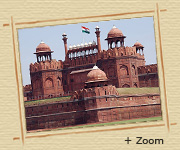
Delhi is the symbol of old India and new ? even the stones here whisper to our ears of the ages of long ago and the air we breathe is full of the dust and fragrances of the past, as also of the fresh and piercing winds of the present.- Jawaharlal Nehru
Delhi, the capital of India is the third largest city of the world, exceeded in size by Calcutta and Mumbai. Delhi is situated in north central India and stands on the west bank of Yamuna river. It is bounded on the east by the state of Uttar Pardesh and on the north, west and south by Haryana. The eternal Yamuna has witnessed the glory and the tumultuous history of the 3000 year old Delhi. Delhi is spread over an area of 1483 sq. kilometers, 216 meters above sea level and has a population of around 14 million. The amalgamation of various cultures, traditions, religions has painted Delhi in colour which are brought from all over India. Delhi is a true cosmopolitan city always on the move. Delhi remains the centre of power. Once it was a city of royal power. Then it became the seat of colonial power. Later it was the seat of bureaucratic power. The seat of political power it has always been. Today it is emerging as an important centre for corporate power too. It is a perfect introduction to the cultural wealth, the complexities and dynamism of India. Delhi has always been the hub of activity, art, culture and the history of the whole country and continues to do so.
It is divided into two parts Old Delhi & New Delhi. |
 |
Delhi at a glanceState: National Capital Territory / Union Territory of Delhi
District: Delhi District
STD Code: 011
Max. Temp.: 46°C
Min. Temp.: 4°C
Winter: Late Nov.-Early Feb.
Spring: March to Mid April
Summer: April end to Aug end
Autumn: Sep to Nov. end
Best Season: October to March
Area: 1,483 sq km
Population: 13,850,507 (2001)
Density: 9,339.52 sq km
|
 |
|
| |
| Old Delhi (Shahjahanabad) |
| |
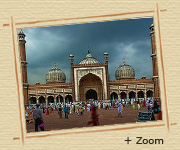
'Old' Delhi, the capital of Muslim India between the mid-17th and late 19th centuries, is full of formidable mosques, monuments and forts. The ancient Delhi of the Mughal emperors was surrounded by a wall and was a congested city of narrow bylanes. Though better known as Old Delhi, this area is also called Delhi. Old Delhi , Shah Jahan's seventeenth-century capital ( Shahjahanabad ), lies 2km or so further north.The Delhi Jn rly stn is in Old Delhi, the inter-state bus terminus is slightly to the north, at the Kashmiri Gate. Buses go to all over north and west India from the Kashmiri Gate. Near the Delhi Gate lies the Yamuna on the left and the Aruna Asaf Ali Rd on the right, ending at Ramlila Pavilion, the juncture of Old and New Delhi.
It's a lively area of colorful bazaars, narrow streets and barely controlled chaos. Monuments in sandstone and marble, which stand in assorted states of repair, make Delhi a veritable museum of Indo-Islamic architecture, seen at its best in the frenetic streets of Old Delhi. Old Delhi looks entirely different from the more modern New Delhi and south Delhi areas. |
| |
| New Delhi |
| |
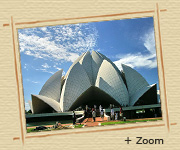
The other Delhi, the imperial city created as the capital of India by the British. In addition to its historic interest and role as the government centre, Delhi is a major travel gateway. In 1911, the British asked Lutyens to give new meaning to city development which is reflected in the architectural designs and sophistication that buildings in Delhi like Parliament House, Rashtrapati Bhavan, India Gate, Connaught Place and various administrative buildings like the South and North blocks along the breathtaking view available from Raj Path. The capital of the Indian republic is at New Delhi, the planned city devised by the British. The smooth roads, modern houses and buildings and offices and departments attract tourist. As you come out of the New Delhi rly stn, in front is Paharganj and on the south Chemsford Road which intersect at Connaught Place. New Delhi, the imperial city created by the British Raj, is composed of spacious, tree-lined avenues and imposing government buildings, and has a sense of order absent from other parts of the city. |
| |
| Other Facts |
-
Delhi has more cars than the other three metros put together. (One million cars, 3.8 million vehicles) Last year 4000 cars were stolen.
- There are more cell phones in Delhi (8 lakhs) than in Mumbai.
- More than 500 people are murdered every year in Delhi.
- More than one woman is raped every day.
- Eight houses are burgled every day.
- Every day there are 3 kidnappings of women.
- Kidnappers demanded more than Rs. 11 crore as ransom in the year 2000.
- Delhi together with Gurgaon and Noida contributed Rs. 6146 crore worth of IT software and services exported in 2000 against Karnataka's Rs 4267 crore.
- Delhi receives 40 per cent of the 20 lakh tourists to the country every year.
- Until the 1960's Delhi had 11 soccer grounds but now only has one.In contrast Delhi has seen 14 golf courses added in the last 5 years to the cities landscape.
- Cyber crime, tender mafia, Islamic militancy, and economic offenses are on the rise in Delhi while inter-state extortion rackets, kidnappings, robberies, and Sikh militancy are decreasing.
- Every decade Delhi adds 40 lakh migrants.
- Last year 1842 people were killed on Delhi's roads. The current average is now 6 per day.
- Delhi adds roughly 500 000 to its population every year.
- Nearly 50 per cent of Multi National Corporations that have entered Indian since the 1990s have chosen Delhi as their base.
- Two new restaurants are added every day to the city. But one-third of its population lives in slums and unauthorized colonies.
- More than 60 per cent of the effluents channeled into the Yamuna is untreated and the water table in some of its most posh areas has receded to 30 m below the surface.
|
| |
| Places of Interest |
| |
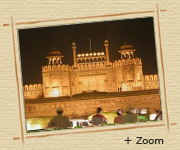 Monuments and Forts Monuments and Forts
Red Fort or Lal Quila:
Shah Jahan, the Mughal emperor, laid the foundation of Red Fort in 1639 and it got completed in 1648. This colossus citadel is built with red stone and that is how the fort got its name. The total area of this fort is about 2.41 km. The fort is octagonal in shape. A wide moat that was originally connected with the river and was filled with water surrounds the fort. The main entrance to the Quila is through the Lahori Gate. Some of the main buildings within the fort are: Diwan-i-Am (hall of public audience), Diwan-i-Khas (hall of selective audience), the Hamam (the bathroom set), Moti Masjid (pearl mosque), Mumtaz Mahal (one of the main palaces), Naubat Khana (music house). After India got its independence from the British rule, the National Flag of India is hoisted at the Red Fort every year on 15th of August by the Prime Minister. This magnificent structure with its historical past is truly glorious and demands your visit.
Humayun's Tomb:
The tomb of Humayun was built by the orders of Humayun's widow, Hamida Banu Begum, starting in 1562. It took 8 years for the tomb to get completed. The structure is built with red sandstone, whereas white and black marble has been used largely in the borders. This tomb is set in a geometrically arranged garden crisscrossed by numerous water channels. It is the first example of Mughal architecture, with high arches and double dome. Humayun's Tomb is one of the best-preserved Mughal monuments in Delhi.
Qutub Minar:
Your trip to Qutub Minar will be fascinating. This world heritage site is located in Mehrauli, South of Delhi. This tallest brick tower in the world, built in 1193 AD, is named after Qutab-ud-din Aibak. He ruled initially from Lahore and later moved the capital to Delhi; he is considered the first Muslim ruler of South Asia. This tower was started by Qutub-ud-Din Aibak but was completed by his son-in-law Iltutmish and ultimately by Firoz Shah Tughlak. This tower is 72.5 meters tall with 399 steps leading to the top. The base is 14.3 meters wide and the top floor is 2.75 meters wide. While visiting this Minar, do not miss the nearby Iron Pillar. You will immensely enjoy the tour of this monument.
India Gate:
You have to visit India Gate, the famous landmark of New Delhi, India. It is one of the largest war memorials in India and commemorates the members of the former British Indian Army who laid their lives fighting for the Indian Empire in World War I and the Afghan Wars. The foundation stone for India Gate was laid in 1921 by the Duke of Connaught and was completed in 1931. This enormous structure was designed by Sir Edwin Lutyens. After India's independence, India Gate became the site of the Indian Army's tomb of the unknown soldier, known as the Amar Jawan Jyoti. The 42 meter high archway is made of red stone and has the name "INDIA" written on both sides. More than 70,000 names of soldiers are also inscribed on the arch. The archway is located on the Rajpath in New Delhi. This monument is surrounded by lawns, children's park and a boat club. Locals and tourists gather near the India Gate and spend their evenings in leisure. |
| |
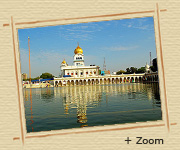 Religious Places Religious Places
Bangla Sahab :-
One of the most important historical and sacred pilgrimage destinations of the Sikh comunity, Gurdwara Bangla Sahib is the Haveli or palace, where Guru Hari Krishan, the eighth Sikh Guru stayed during his tour to Delhi in 1664. The Guru was entertained as a royal guest by Mirza Raja Jai Singh in this bangla (palace), which was built on the model of the existing palace of Raja Jai Singh in Jaipur.
Lotus Temple: This Baha'i House of Worship is in the shape of lotus. That is the reason this temple is called Lotus Temple. This beautiful structure was opened to public in December 1986. The temple is so popular that it is one of the most visited places in the world. When you enter this temple, you have to maintain a pin drop silence. The atmosphere inside the temple is calm and serene. Visiting this temple is once in a lifetime experience.
Jama Masjid:
This mosque is located nearby the Red Fort. It was built between 1644 and 1658 by the Mughal emperor, Shah Jahan. It is one of the last architectural works of Shah Jahan. Jama Masjid is the largest mosque in India. The first three storeys of the Jama Masjid tower is made of red sandstone, the fourth one is made of marble, while the fifth is made of sandstone. The masjid is covered with intricate carvings and has verses inscribed from the holy Quran. The spacious courtyard of the Jama Masjid can hold thousands of Muslim followers.
ISKCON Temple:
This temple is built by the Hare Rama Hare Krishna cult followers. ISKCON Temple is dedicated to the Hindu god, Lord Krishna. It is erected on a hillock. This complex is gracefully built and is one of the largest temple complexes in India. You will be impressed with the temple and its propaganda throughout the world. |
| |
| |
| |
|
|




